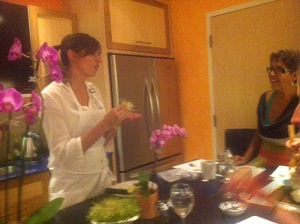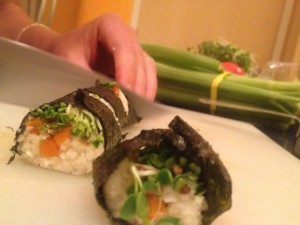Growing up, I was the world’s pickiest eater. I ate nothing but chicken, cereal and salads. So when I was first taken out for sushi, I remember it clearly. One of my father’s friends took me out to a popular sushi place in Miami Beach, Florida. Surprisingly, I loved everything about my experience; the different flavors and textures were so different from what I ever had.
As we all know, sushi is quite expensive. And so I thought I’d make a go at preparing sushi at home. Furthermore, why not teach a class at Coda Health Kitchen’s raw foods kitchen? The wheels started spinning.
 What were my goals in teaching a vegetarian and raw sushi class at Coda Health Kitchen? As we teach here at CHK, eating raw and vegetarian foods is extremely beneficial for our health. Cooking food destroys much of the natural enzymes in your food that are needed to break down nutrients. Incorporating raw food dishes in your diet eliminates this problem. Green leafy vegetables are typically the highest source of enamel-building minerals in a raw food diet and skimping on them could negatively impact your dental health.
What were my goals in teaching a vegetarian and raw sushi class at Coda Health Kitchen? As we teach here at CHK, eating raw and vegetarian foods is extremely beneficial for our health. Cooking food destroys much of the natural enzymes in your food that are needed to break down nutrients. Incorporating raw food dishes in your diet eliminates this problem. Green leafy vegetables are typically the highest source of enamel-building minerals in a raw food diet and skimping on them could negatively impact your dental health.
In addition to my nutrition-based goal, I wanted to teach how to make sushi rice the right way (yes there is a right way to cook the rice), different rolling techniques, the tools of the trade and more. Furthermore, I wanted to include a “raw” version of sushi using shredded Jicama as a rice alternative. I wanted my attendees to leave having the confidence to impress their friends at home with some serious sushi rolling skills.
I also love to teach attendees of my classes and patients the importance of “eating for healthy teeth”. Did you know there are foods that are good (and bad) for your teeth? According to Mike Theobald, at EverydayHealth, “Red peppers and sweet potatoes can provide the vitamin C necessary for healthy gums, which help keep your teeth firmly in place. Citrus fruits like oranges are also high in vitamin C, but you have to be careful of their acidity. Learn more about pH and acidity here.
Furthermore, Theobald states: “The crisp texture of crunchy fruits and vegetables can help wipe away plaque-causing bacteria on your teeth. They can also increase the production of saliva, which helps neutralize bacteria in your mouth. Apples, pears, celery, and carrots are all good choices. However, even a healthy food like an apple can expose teeth to damaging acid when eaten slowly. To reduce the impact of acid, brush your teeth before eating and drink water or rinse immediately after.” I wanted to teach this to all of my attendees by having them make and taste these dishes. We are always taught what not to eat for your teeth, but little is mentioned on what is actually good for your teeth.
teeth. They can also increase the production of saliva, which helps neutralize bacteria in your mouth. Apples, pears, celery, and carrots are all good choices. However, even a healthy food like an apple can expose teeth to damaging acid when eaten slowly. To reduce the impact of acid, brush your teeth before eating and drink water or rinse immediately after.” I wanted to teach this to all of my attendees by having them make and taste these dishes. We are always taught what not to eat for your teeth, but little is mentioned on what is actually good for your teeth.
So on to the class.
Rolling sushi takes practice. It looks simple enough, but that’s not the case. Sometimes the filling is off center, the rice isn’t firm enough or you’ve left too much seaweed (nori) on the edges. As I stressed in my class, have patience, it’ll come.
Making vegetarian and raw sushi is much easier if you have the right tools. Here’s what you need:
• Rice cooker – A cooker makes rice consistently each time and allows you to cook the rice without constantly watching or stirring, providing time to prep the other ingredients. It’s hard to make good sushi rice in a sauce pan.
• Sushi-grade knives – It is very important to have a good, sharp knife for cutting your vegetables and sushi rolls.
• Rice rolling mat and plastic wrap to keep rice from sticking to it, and prevent it from being washed frequently to prevent frequent replacements.
• Large bowl for mixing and cutting sushi rice, preferably wood.
• Rice paddle or wooden spoon for “cutting” sushi rice
• Small bowls and plates for lining up ingredients and for final presentation
• Cutting board
• Colander or bowl for washing rice and vegetables
• Dish cloths to wipe hands and utensils
Next you want to line up all of your ingredients. I wanted to make 2 kinds of rolls; a raw foods version and a vegetarian version. What would you use in place of rice for a raw foods sushi, you may ask. Jicama. It was a huge hit and I was surprised on how popular the raw version was. I placed the jicama in our food processor and pulsed it until it turned into rice sized pieces. It’s very important not to over process your jicama because it turns into mush. I then laid the jicama on a clean towel to soak up the extra moisture.
Both the raw sushi and the vegetarian sushi were delicious. And so much fun to make, as you can see in the pictures. Keep the tips below in mind.
A few sushi-making tricks:
1. If you make the raw foods sushi, try seasoning the jicama as you do the rice
2. Have a cup nearby when slicing the sushi rolls to dip your knife into it. This
makes cutting much easier.
3. Once again, I’d like to reiterate, have a good sushi knife on hand.
We hope to see you at a Coda Health Kitchen class in the near future. We always have fun and learn a lot. Keep in mind that sushi is about subtle combinations kept simple: seasoned rice, seasonal produce at peak flavor and flavoring from sauces and condiments. Learn the art of hand rolling and once you’ve mastered the basics, you’ll be prepared to make great sushi at home whenever the craving arrives! Kanpai!

June 2013
Bridget Hobart
Coda Health Kitchen Consultant